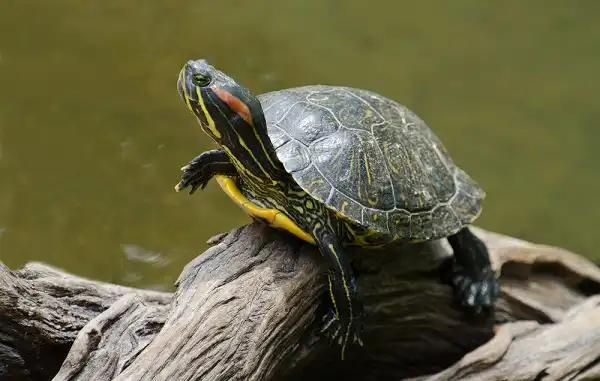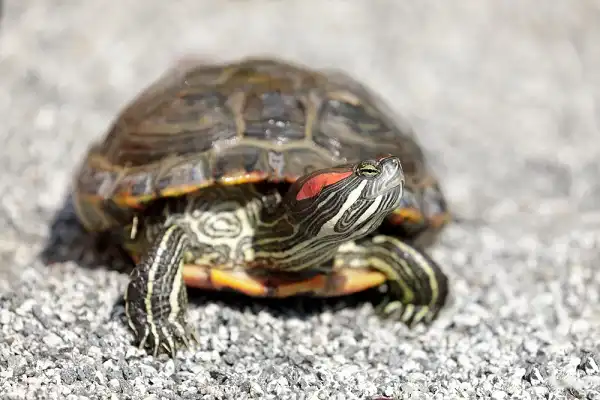Are you looking for a pet that comes with low maintenance but can still keep your home buzzing? The Red Eared Slider may be the perfect choice! These small turtles are a popular choice due to their relatively easy care requirements and recognizable red ears. If you’re considering adding these water-dwellers to your family, there are some important things you should know about feeding, housing, and keeping them healthy. Read on for more information about this fascinating creature and what it takes to have successful pet ownership of a Red Eared Slider!

Red Eared Slider Description
The Red Eared Slider, also known as Trachemys scripta elegans, is a freshwater turtle species belonging to the family Emydidae. One of the most striking features of the Red Eared Slider is its recognizable red markings on the sides of its head. This distinctive marking gives the species its name and makes it easily recognizable among other turtle species. They have a smooth shell that is typically olive or brownish-green with yellow stripes, and their skin is usually green with yellow stripes on the arms and legs.
Red Eared Slider Habitat
Red Eared Sliders are one of the most popular pet turtle species due to their small size and easy care. They are native to the southern United States, where they inhabit a range of aquatic habitats, including ponds, lakes, and slow-moving streams. Red Eared Sliders are semi-aquatic turtles that require a specific environment to thrive. Their habitat should include both land and water areas. The water should be clean and free of chemicals, with a water heater to maintain a temperature between 75-80°F. A daily water change of 25-50% is recommended to keep the water clean and avoid the accumulation of ammonia and other toxins. The basking area should be large enough for the turtle to move around and have access to both heat and UV light. The temperature under the basking light should be around 90°F, with a UV light bulb that meets specific requirements. The basking area should be cleaned daily to avoid bacteria growth, and the light bulbs should be replaced every six months to ensure optimal performance.
Red Eared Slider Diet
Red Eared Sliders are omnivorous turtles and require a diverse diet to maintain their health and well-being. They have a generalized diet and are opportunistic feeders in the wild, eating almost anything they can find, including insects, fish, plants, and fruits. A varied and balanced diet is essential for Red Eared Sliders in captivity to prevent nutritional deficiencies and health issues. They should be fed a mix of protein, vegetation, vitamins, and minerals to ensure their nutritional requirements are met. One of the primary sources of protein in a Red Eared Slider’s diet is commercial turtle pellets. High-quality turtle pellets usually contain the right balance of protein, fat, and fiber, and are fortified with essential vitamins and minerals.
They are readily available in pet stores and are convenient to store and use. However, pellet diets should not make up the entire diet, as they may lack some essential nutrients and may not provide the necessary enrichment and stimulation. Vegetables and fruits are also essential in a Red Eared Slider’s diet. They provide necessary vitamins, minerals, fiber, and water. Some of the best vegetables for Red Eared Sliders include kale, collard greens, mustard greens, dandelion greens, and squash. On the other hand, fruits such as strawberries, apples, and bananas are great treats for Red Eared Sliders but should be given in moderation.

Red Eared Slider Size
Red Eared Sliders are medium-sized turtles and can grow up to 11 inches in length, with females being slightly larger than males. Their size is determined by various factors such as genetics, diet, housing conditions, and age. Juvenile Red Eared Sliders are typically 1 to 2 inches in length at hatching and can grow quickly, reaching the size of an adult in about 3 to 5 years. However, their growth rate can be affected by several factors, including temperature, diet, and overall health. Adult Red Eared Sliders can grow up to 11 inches in length, with the average size being around 6 to 8 inches. Females tend to be larger than males, with a plastron length of up to 9 inches, while males have a plastron length of up to 6 inches.
Red Eared Slider Lifespan
Red Eared Sliders are a favorite among pet owners due to their small size and easy care, but it’s important to note that these turtles have a long lifespan – up to 30 years or more – and their size can continue to grow throughout their life. Their lifespan is influenced by factors such as genetics, diet, temperature, housing conditions, and overall health. To promote a long and healthy life for your Red Eared Slider, it’s crucial to provide them with a healthy and balanced diet, adequate housing and temperatures, and regular veterinary check-ups.
In the wild, Red Eared Sliders face threats such as habitat loss, water pollution, and predation, which can impact their lifespan. However, in captivity, if provided with proper care and a suitable environment, they can live a long and healthy life. Their habitat should be spacious enough to allow them to move around freely, bask, and swim. It’s recommended to provide ten gallons of water per inch of turtle, so a tank size of at least 55 gallons is necessary for an adult Red Eared Slider.
Red Eared Slider Behavior
Red Eared Sliders are fascinating creatures that exhibit a wide range of interesting behaviors. These turtles are known for their friendly and curious personalities, and they are relatively active and energetic, especially when compared to other turtle species. One of the most common behaviors exhibited by Red Eared Sliders is basking. These turtles love to bask in the sun, often for many hours at a time. They will typically climb out of the water and onto a dry patch of land or a basking platform to soak up the sun and warm themselves. This behavior is essential for their overall health, as it helps to regulate their body temperature and aids in digestion. Red Eared Sliders are also social creatures and enjoy spending time with other turtles.
They can often be found basking or swimming together, and they may engage in various social behaviors such as nudging, biting, and head bobbing. While they can sometimes be aggressive towards each other, especially during the breeding season, they generally get along well with other turtles and thrive in a community environment. Another interesting behavior exhibited by Red Eared Sliders is their ability to communicate with each other. These turtles are known to produce a variety of vocalizations, such as hissing and chirping, and they use these sounds to communicate with other turtles. They may also use body language, such as posturing and head bobbing, to convey messages.

Red Eared Slider Speed
Red Eared Sliders are not only curious and social creatures but they are also known for their exceptional speed in water. They are strong and agile swimmers, able to move through the water with remarkable speed. These turtles have four webbed feet designed for maximum propulsion through the water, and their streamlined shell allows for minimal drag. They can swim at a speed of up to 20 miles per hour, which is incredibly fast and efficient for their size. This is necessary for their survival in the wild, as they hunt for food and evade predators while swimming. Red Eared Sliders have a unique swimming style that allows them to achieve such high speeds. They use their hind legs to propel themselves forward, while their front legs are used for steering and maneuvering. Their long tails serve as rudders and help them to make quick turns and twists in the water. It’s important to note that while Red Eared Sliders are fast swimmers, they are not designed for endurance swimming. This means that they cannot swim for long distances without rest. As such, it’s essential to provide them with a spacious tank that allows them plenty of space to swim and rest.
Red Eared Slider Hunting
Red Eared Sliders are known for their remarkable swimming abilities, which are not only useful for quickly evading danger but also for efficiently hunting their prey. These curious turtles have a diverse diet that includes fish, insects, and crustaceans, which they can catch while swimming at impressive speeds. When hunting, Red Eared Sliders use their keen senses to detect their prey, often relying on their sight to spot movements in the water. Once they have spotted their prey, they will quickly swim toward it and use their sharp claws to grab it with their strong jaws. Their hunting skills are aided by their unique swimming style, which allows them to move through the water with incredible speed and agility.
Their hind legs are used to propel them forward, while their front legs are used for steering and maneuvering. This enables them to make quick turns and twists in the water, as well as to adjust their direction as needed to catch their prey. Red Eared Sliders are also known for their ability to calculate and anticipate the movements of their prey. They can accurately predict where their prey will be and make calculated maneuvers to intercept it. This ability is especially important when hunting fast-moving prey, such as fish, which require precise timing and reflexes.
Red Eared Slider Reproduction
Red Eared Sliders are sexually mature between 4-5 years of age and typically reach breeding age during the spring months. During this period, they engage in courtship rituals that involve pushing, biting, and even head bobbing. Once paired up, male sliders will mount the female before releasing a spermatophore that contains spermatozoa. The female then picks up the spermatophore with her plastron (bottom shell) which allows the sperm to travel into her oviducts where fertilization occurs. In captivity, females may lay eggs within 2 weeks of mating and can produce multiple nests throughout the year if kept warm enough. Each clutch consists of approximately 6-14 eggs that are laid in shallow nests dug out of the substrate. The eggs will incubate for 45-65 days before hatching and typically produce offspring of 2-4 turtles.

Conclusion
Red Eared Sliders are amazing creatures that have adapted to their aquatic environment in remarkable ways. Their unique swimming style, quick reflexes, and efficient hunting techniques enable them to move through the water with incredible speed and agility. Understanding their abilities is essential for providing them with suitable housing and ensuring their optimal health and well-being. As pet owners, it’s important to appreciate the natural abilities of our turtles and respect their needs for space, nutrition, and enrichment. With proper care, Red Eared Sliders can live long and healthy lives in captivity.
Frequently Asked Question

